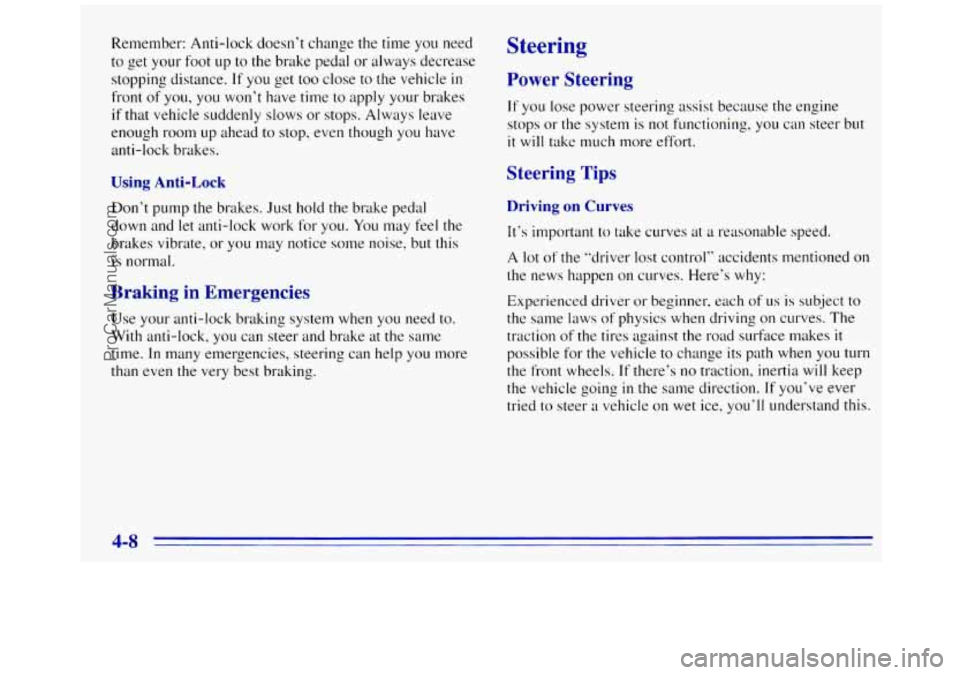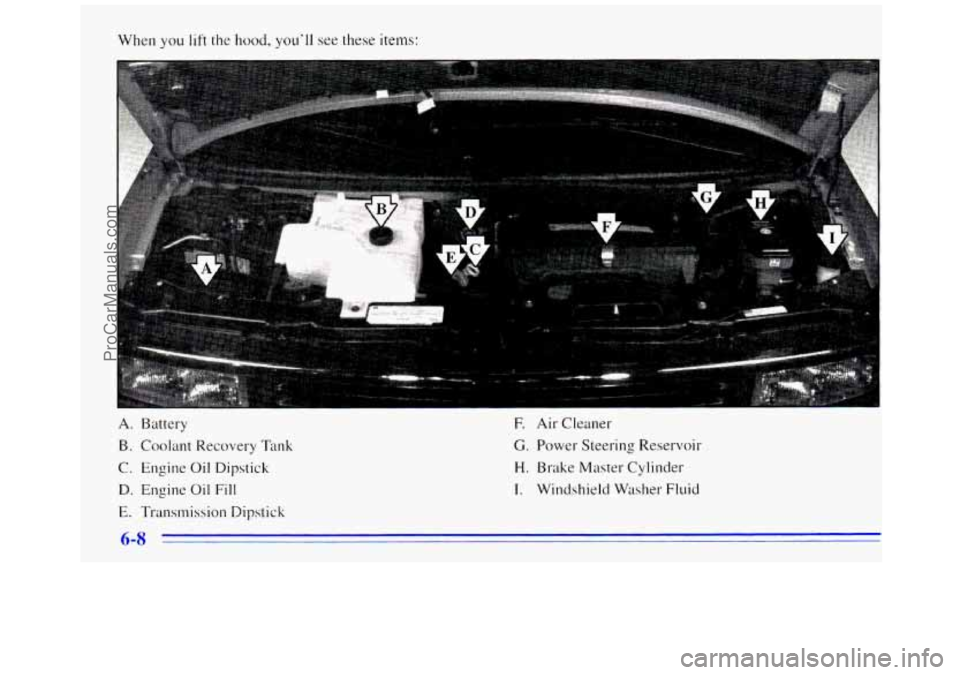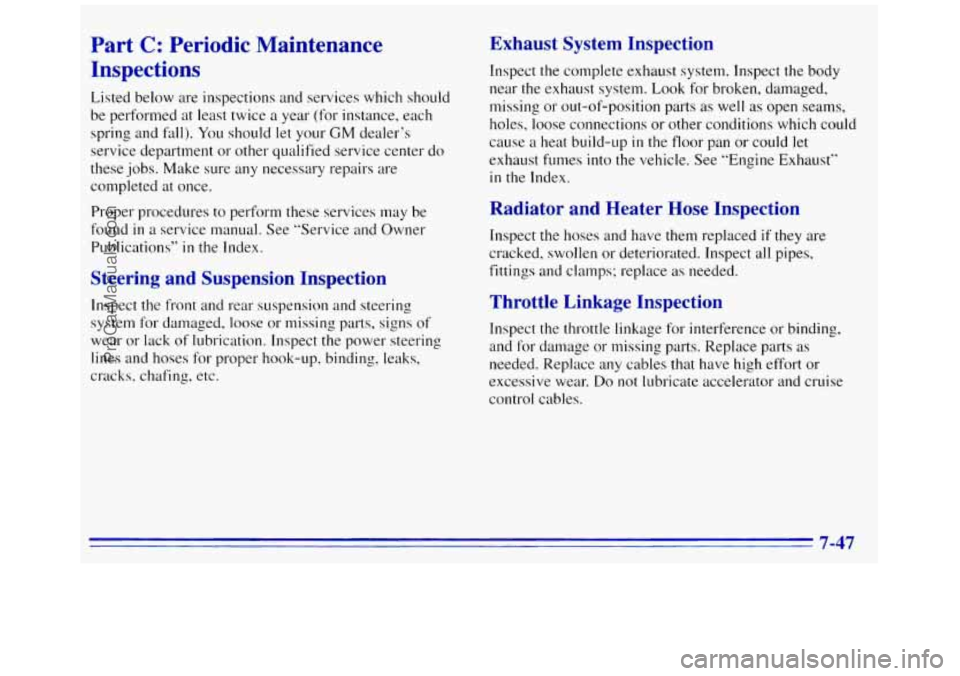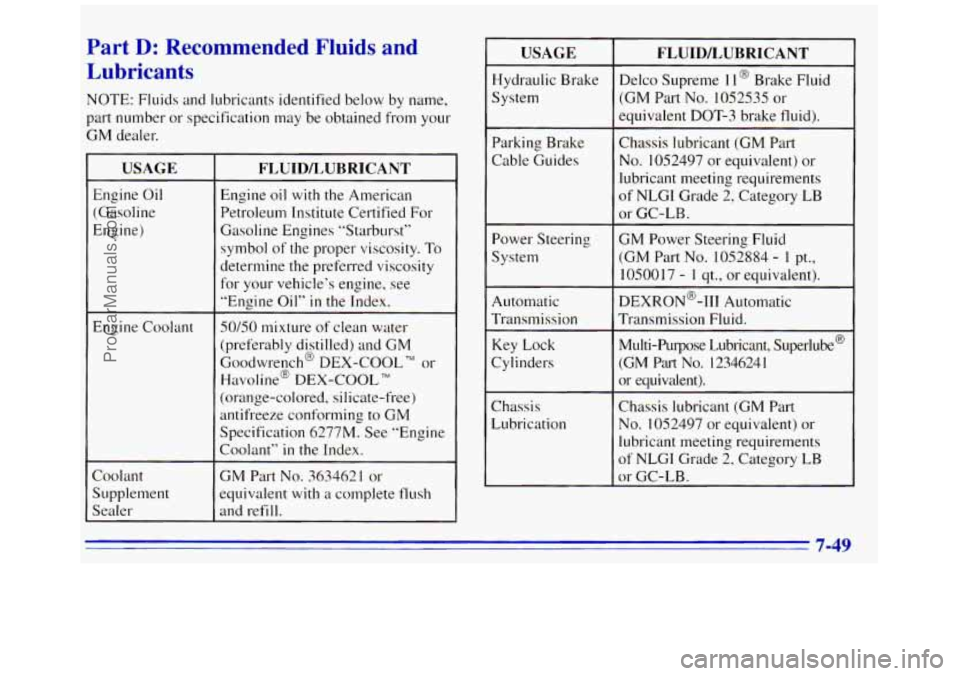1996 GMC SAVANA power steering
[x] Cancel search: power steeringPage 71 of 372

New Vehicle “Break-In”
NOTICE:
Your modern vehicle doesn’t need an elaborate
“break-in.” But it will perform better in the long
run if you follow these guidelines:
0
0
0
0
Keep your speed at 55 mph (88 kmh) or
less for the first
500 miles (804 km).
Don’t drive at any one speed
0- fast or
slow
-- for the first 500 miles (804 km).
Don’t make full-throttle starts. Avoid making hard stops for the
first
200 miles (322 km) or so. During this time
your new brake linings aren’t yet broken
in. Hard stops with new linings can mean
premature wear and earlier replacement.
Follow this breaking-in guideline every
time you get new brake linings.
Don’t tow
a trailer during break-in. See
“Towing a Trailer” in the Index for more
information.
Ignition Switch
Your key lets you turn the ignition switch to five
different positions.
C
I
ACCESSORY (A): ACCESSORY lets you use
things like the radio, power windows and the
windshield wipers when the engine
is off. To get into
ACCESSORY, push in the key and turn it toward you.
Your steering wheel will remain locked, just as it was
before
you inserted the key.
2-13
ProCarManuals.com
Page 156 of 372

Remember: Anti-lock doesn‘t change the time you need
to get your foot
up to the brake pedal or always decrease
stopping distance.
If you get too close to the vehicle in
front of you, you won‘t have time to apply your brakes
if that vehicle suddenly slows or stops. Always leave
enough room up ahead
to stop, even though you have
anti-lock brakes.
Using Anti-Lock
Don’t pump the brakes. Just hold the brake pedal
down and let anti-lock work for you. You may feel the
brakes vibrate,
or you may notice some noise. but this
is normal.
Braking in Emergencies
Use your anti-lock braking system when you need to.
With anti-lock,
you can steer and brake at the same
time.
In many emergencies, steering can help you more
than even the very best braking.
Stc . ring
Power Steering
If you lose power steering assist because the engine
stops
or the system is not functioning, you can steer but
it will take much more effort.
Steering Tips
Driving on Curves
It’s important to take curves at a reasonable speed.
A lot of the “driver lost control” accidents mentioned on
the news happen
on curves. Here’s why:
Experienced driver or beginner, each of us is subject to
the same laws of physics when driving on curves. The
traction of the tires against the road surface makes
it
possible for the vehicle to change its path when you turn
the front wheels. If there‘s no traction, inertia will keep
the vehicle going
in the same direction. If you‘ve ever
tried to steer a vehicle on wet ice, you’ll understand this.
4-8
ProCarManuals.com
Page 232 of 372

When you lift the hood, ~011’11 see these items:
A. Battery
B. Coolant Recovery Tank
C. Engine Oil Dipstick
D. Engine Oil Fill
E. Transmission Dipstick
F. Air Cleaner
G. Power Steering Reservoir
H. Brake Master Cylinder
I. Windshield Washer Fluid
ProCarManuals.com
Page 248 of 372

Thermostat
Engine coolant temperature is controlled by a thermostat
in the engine cooling system. The thermoskt stops the
tlow of coolant through the radiator until the coolant
reaches
a preset temperature.
When you replace your thermostat,
an AC@ thermostat
is recommended.
Power Steering Fluid
When to Check Power Steering Fluid
It is not necessary to regularly check power steering
tluid unless you suspect there
is a leak in the system or
you hear an unusual noise.
A fluid loss in this system
could indicate a problem. Have the system inspected
and repaired.
How To Check Power Steering Fluid
When the engine compartment is cool, unscrew the cap
and wipe the dipstick with a clean rag. Replace the cap
and completely tighten
it. Then remove the cap again
and
look at the fluid level on the dipstick.
The level should be at the FULL COLD mark. If
necessary, add only enough fluid to bring
the level up to
the mark.
To prevent brake fluid contamination, never check or
fill
the power steering reservoir with the master cylinder
cover off.
What to Use
Refer to the Maintenance Schedule to determine what
kind
of fluid to use. See “Recommended Fluids and
Lubricants”
in the Index. Always use the proper fluid.
Failure to use the proper fluid can cause leaks and
damage hoses and seals.
ProCarManuals.com
Page 343 of 372

Part C: Periodic Maintenance
Inspections
Listed below are inspections and services which should
be performed at least twice a year (for instance, each
spring and fall).
You should let your GM dealer’s
service department or other qualified service center do
these
jobs. Make sure any necessary repairs are
completed at once.
Proper procedures to perform these services may be
found
in a service manual. See “Service and Owner
Publications”
in the Index.
Steering and Suspension Inspection
Inspect the front and rear suspension and steering
system for damaged,
loose or missing parts, signs of
wear or lack of lubrication. inspect the power steering
lines and hoses for proper hook-up, binding, leaks,
cracks, chafing, etc.
Exhaust System Inspection
Inspect the complete exhaust system. Inspect the body
near the exhaust system. Look for broken, damaged,
missing or out-of-position parts as well as open seams,
holes, loose connections or other conditions which could
cause
a heat build-up in the floor pan or could let
exhaust fumes into the vehicle. See “Engine Exhaust”
in the Index.
Radiator and Heater Hose Inspection
Inspect the hoses and have them replaced if they are
cracked, swollen or deteriorated. Inspect all pipes,
fittings and clamps; replace as needed.
Throttle Linkage Inspection
Inspect the throttle linkage for interference or binding,
and for damage or missing parts. Replace parts as
needed. Replace
any cables that have high effort or
excessive wear. Do not lubricate accelerator and cruise
control cables.
7-47
ProCarManuals.com
Page 345 of 372

Part D: Recommended Fluids and
Lubricants
NOTE: Fluids and lubricants identified below by name,
part number or specification may be obtained from your
GM dealer.
USAGE
Engine Oil
(Gasoline
Engine)
Engine Coolant
Coolant
Supplement
Sealer
FLUID/LUBRICANT
~~ ~
~~
Engine oil with the American
Petroleum Institute Certified For
Gasoline Engines “Starburst“
symbol
of the proper viscosity. To
determine the preferred viscosity
for your vehicle’s engine, see
“Engine Oil”
in the Index.
50150 mixture of clean water
(preferably distilled) and GM
Goodwrench@ DEX-COOL
TM or
Havo line@
DEX-COOL TM
(orange-colored, silicate-free)
antifreeze conforming to GM
Specification 6277M. See “Engine
Coolant”
in the Index.
GM Part No. 3634621 or
equivalent with
a complete flush
and refill.
USAGE
Hydraulic Brake
System
Parking Brake
Cable Guides
~~
Power Steering
System
Automatic
Transmission
Key Lock
Cylinders
Chassis
Lubrication
FLUIDLUBRICANT
Delco Supreme 1 1 @ Brake Fluid
(GM Part No. 1052535 or
equivalent DOT-3 brake fluid).
Chassis lubricant (GM Part
No. 1052497 or equivalent) or
lubricant meeting requirements
of NLGI Grade 2, Category LB
or GC-LB.
GM Power Steering Fluid
(GM Part
No. 1052884 - 1 pt.,
1050017
- 1 qt., or equivalent).
DEXRON@-111 Automatic
Transmission
Fluid.
Multi-Purpose Lubricant, Superlube@
(GM
Pd-t No. 1234624 1
or equivalent).
Chassis lubricant
(GM Part
No. 1052497 or equivalent) or
lubricant meeting requirements
of NLGI Grade 2, Category
LB
or GC-LB.
7-49
ProCarManuals.com
Page 366 of 372

Locks Cylinders
................................... 7-44
Door
........................................ 2-3
Key Lock Cylinder Service ..................... 7-44
PowerDoor
.................................. 2-3
Rear Door Security
............................. 2-4
Sliding Door Child Security
...................... 2-4
Steering Column Lock Check
.................... 7-46
Loss
of Control ................................ 4- 12
Lubricants and Fluids
............................ 7-49
Lubrication Service. Body
........................ 7-44
Maintenance. Normal Replacement Parts
........... 6-65
Maintenance Record
............................ 7-5 1
Maintenance Schedule ............................ 7- 1
Long Trip/Highway Definition ................... 7-5
Long Trip/Highway Intervals
..................... 7-6
Owner Checks and Services
..................... 7-43
Periodic Maintenance Inspections
................ 7-47
Recommended Fluids and Lubricants
............. 7-49
Scheduled Maintenance Services
.................. 7-3
Short Trip/City Definition
....................... 7-4
Short Trip/City Intervals
........................ 7-4
Maintenance. Underbody
......................... 6-58
Maintenance When Trailer Towing ................. 4-37
Malfunction Indicator Lamp
...................... 2-50
Manual Front Seat
............................... 1 - 1
Manual Mirror ................................. 2-40
Methanol
...................................... 6-3
Mirrors
....................................... 2-40
Convex Outside
.............................. 2-39 Inside
Day/Night Rearview
..................... 2-39
Manual
..................................... 2-40
Power Remote Control
......................... 2-39
Visor
Vanity ................................. 2-42
MMT
......................................... 6-3
Model Reference ................................. vi
Mountain Roads ................................ 4-21
Multifunction Lever
............................. 2-29
Neutral. Automatic Transmission
................. 2-18
New Vehicle Break-In ........................... 2-13
Nightvision
................................... 4-14
Noise Control System
............................ 6-9
Odometer
.................................... 2-45
Odometer. Trip
................................. 2-45
Off-Road Recovery
............................. 4- IO
Oil. Engine .................................... 6-11
Overheating Engine ............................. 5- IO
Owner Checks and Services ....................... 7-43
Owner Publications. Ordering
...................... 8-9
Paint Spotting. Chemical ......................... 6-58
Park
Automatic Transmission
....................... 2-17
Shifting Into
........ ; ........................ 2-21
Shifting Out of
............................... 2-23
9-6
ProCarManuals.com
Page 367 of 372

Parking AtNight
.................................... 2-12
Brake
...................................... 2-20
Brake Mechanism Check
....................... 7-46
Lots
....................................... 2-12
Over Things That Burn
........................ 2-24
With
a Tra~ler ................................ 4-36
Passenger Position
.............................. 1-29
Passenger Temperature Control
..................... 3-5
Passing ....................................... 4-11
Periodic Maintenance Inspections
.................. 7-47
Power
Antenna
Mast Care ............................ 3-29
Option Fuses
................................ 6-61
Remote Control Mirror
........................ 2-39
Seat
......................................... 1-2
Steering
..................................... 4-8
Steering Fluid
................................ 6-24
Windows ................................... 2-26
Power Seat
Pregnancy. Use of Safety Belts
.................... 1-29
Problems on the Road
............................ 5-1
Publications. Service and Owner .................... 8-9
DoorLocks
................................... 2-3
Radiator
..................................... 5- I6
Radiator Pressure Cap ........................... 6-23
Radio Reception
................................ 3-26
Radios
......................... 3.9.3.11.3.13. 3.19
Rain. Driving
In ................................ 4- I5
Reading Lamps ................................ 2-38 Rear
Axle
....................................... 6-19
Door Security
Locks ........................... 2-4
Outside Seat Position
.......................... 1-30
Storage ..................................... 2-41
Towing
...................................... 5-9
Window Defogger
............................. 3-8
Rearview Mirror ................................ 2-39
Recovery Tank. Coolant
.......................... 5-13
Refrigerants. Air Conditioning .................... 6-68
Remote Compact Disc Player
..................... 3-17
Removing the Rear Seat
........................... 1-6
Replacement Seatpassengers
.............................. 1-29
Reclining Front Seatbacks
......................... 1-3
Bdbs ...................................... 6-69
Parts
....................................... 6-65
Wheel
...................................... 6-48
Replacing Safety Belts
........................... 1-48
Replacing the Rear Seat
........................... 1-7
Reporting Safety Defects
.......................... 8-8
Restraints Checking
................................... 1-48
Child
....................................... 1-37
Head ........................................ 1-5
Replacing Parts After a Crash ................... 1-48
Systemcheck ................................ 7-44
Reverse. Automatic Transmission
.................. 2-18
Right Front Passenger Position
.................... 1-29
Roadside Assistance
.............................. 8-4
Roadside Assistance. Canadian
..................... 8-6
Rocking Your Vehicle
........................... 5-36
Rotation. Tires
................................. 6-43
9-7
ProCarManuals.com